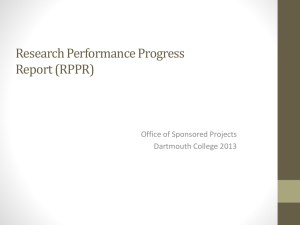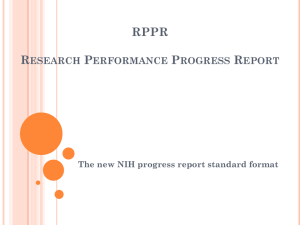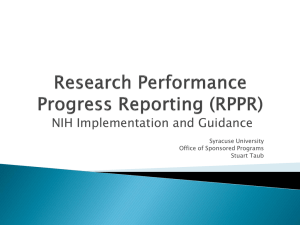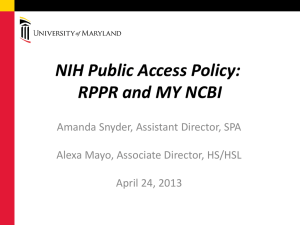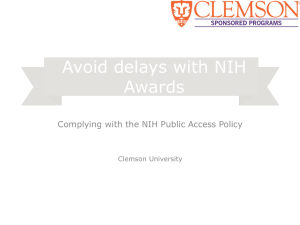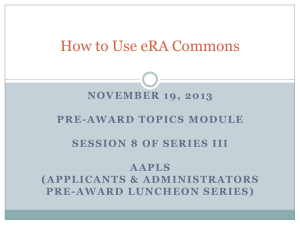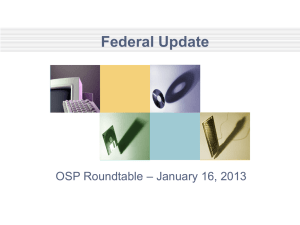RPPR - Office of Research Administration
advertisement
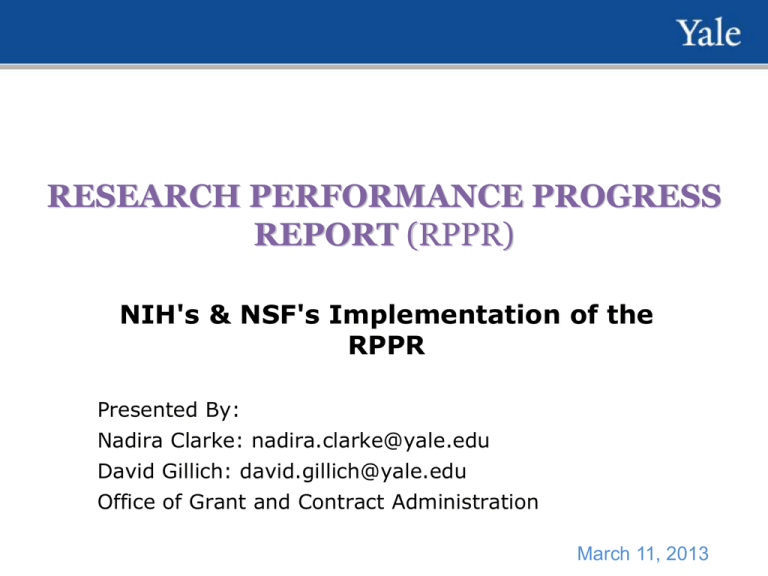
RESEARCH PERFORMANCE PROGRESS REPORT (RPPR) NIH's & NSF's Implementation of the RPPR Presented By: Nadira Clarke: nadira.clarke@yale.edu David Gillich: david.gillich@yale.edu Office of Grant and Contract Administration March 11, 2013 Agenda • Background • NIH RPPR – – – – – – Components Guidelines GCA Procedures Demo Progress Report Additional Materials (PRAM) Resources • NSF RPPR – – – – Guidelines Demo Progress Report Additional Materials (PRAM) Resources 2 Background • National Science and Technology Council (NSTC) Initiative – Create consistency across federal agencies in administering their research awards. – Facilitate the development of a common electronic solution for collecting the information. – Replace current reporting formats. – Does not change the performance reporting requirements in 2 CFR part 215 (OMB Circular A–110) OMB Circular, Cost Principles for Educational Institutions 2 CFR, Part 215 http://www.whitehouse.gov/sites/default/files/omb/assets/omb/fedreg/2005/0831 05_a21.pdf NIH RPPR: Components • Collects the following categories of information: – Standard Cover Page – Mandatory Component (Accomplishments) – Optional Components (Agency Specific) • Agencies will utilize standard instructions developed for each category, but may also provide additional program-specific instructions necessary to clarify requirement for a particular program Important Note: Adhere to Agency Specific Instructions NIH RPPR: Guidelines PHS Agencies and NSF are implementing now. – DHHS - NIH and Other Public Health Service (PHS) Agencies – Office of Justice Programs – Dept of Human Svc (DHS) – National Aeronautics and Space Administration (NASA) – Dept of Correction (DOC) – Dept of Defense (DOD) – Environmental Protection Agency (EPA) – Dept of Energy (DOE – Natl Endowment for the Humanities (NEH) – National Institute of Justice/Office of Justice Programs – NSF – US Drug Administration (USDA) – DoEd/Institute of Education Sciences – Forest Service – Dept of Justice (DOJ) – Natl Institute of Food and Agriculture (NIFA) National Institutes of Health Research Performance Progress Report Effective NOW; expanding 4/18/13 NIH RPPR: Guidelines • Replaces: – the Public Health Service (PHS) Non-competing Continuation Progress Report (PHS 2590) and – the Ruth L. Kirschstein National Research Service Award Individual Fellowship Progress Report for Continuation Support (PHS 416-9). NIH RPPR: Guidelines • Similarities eSNAP vs. RPRR – Describes progress, study results, the significance of the findings, and any significant changes. – Pre-populates information from NIH systems. – MyNCBI publications list displayed. – Detailed budget not required. – NIH policy requirements requested. NIH RPPR: Guidelines • Differences eSNAP vs. RPRR – Separate screens for reporting components. – Non-SNAP awards budget component is a SF424(R&R) Budget. – Uses checkbox, text box, PDF, or selecting “Nothing to Report.” – Required information for all foreign collaborations. – Effort rounded to nearest whole person month. – Location required for competitive revisions/administrative supplements associated with the award. – Public Access compliance status displayed – Other support required only if changed from prior reports – Link to Notice of Award – Streamlined ClinicalTrials.gov reporting information NIH RPPR: Guidelines RPPRs Required NIH RPPR: Guidelines • Status of NON-SNAP Applications – NIH is currently working on the implementation of the RPPR for non-SNAP awards – Paper PHS 2590 must be used for progress reports for awards that require annual budgets, e.g.,: – Training (T) awards, – most multi-project awards • P01 • P30 • P50 NIH RPPR:Guidelines • Due Dates are the same as today – Available in the eRA Commons Status system – Available in the eRA Quick Queries system. – Automatic email notifications sent to the PD/PI prior to due date. • SNAP - 45 days prior to the start of the next budget period • Fellowships - two months prior to the start of the next budget period. • Notice of Award (NoA) May indicate a different due date which supersedes the above dates. Grantees should consult the NoA to determine when SNAP procedures apply. NIH RPPR:Guidelines • RPPR Structures A. B. C. D. E. F. G. H. Cover Page Accomplishments Products Participants Impact Changes Special (NIH) Reporting Requirements Budget – SF424 (R&R) forms NIH RPPR: Guidelines • RPRR Features – Report Data Entry • Text boxes • PDF files • Nothing to Report/Not applicable • No Change – Special Characters • Data fields and text entry boxes only support ASCII characters: Greek letters, mathematical equations, images, and so-called “rich” text (including bold, italic, underline, superscript, subscript, strikethrough, etc.) are not permitted. NIH RPPR: Guidelines • RPPR Features – Data or Text Box, and PDF Size Limits • Limit text responses to no more than one page, or approximately 2,800 characters. – Text boxes contain a limit of no more than 8,000 characters (3 pages) – PDF file attachments do not have page limits, but may not be more than 6 megabytes (6MB). • PDF attachments utilized only to provide considerable detail – PIs are encouraged to be concise and avoid unnecessary detail. NIH RPPR Guidelines • RPPR Features – PDF Attachments and File Names – PDF files can be attached to the appropriate component in the progress report. • PDF’s used to preserve document formatting. • PDF attachments must be submitted as individual files. –eRA systems cannot support “Bundling” or “Portfolio” features at this time. • PDF paginated discouraged. • Descriptive file names - 50 characters or less - no special characters. NIH RPPR: Guidelines • RPPR Features – Style – Use English and avoid jargon. • Abbreviations and language that may not be known to the broader scientific community should be avoided unless clearly defined. – Internet Web site addresses (URLs) should not be used unless provided under C.2 GCA Procedure Proposal Development (PD) – Create RPPR in Commons – Create child record and route to PI, department and GCA – Submit thru Commons Non-Proposal Development (PD) – Create RPPR in Commons – Submit fully signed TranSum to GCA – Submit thru Commons eRA COMMONS - Demo http://grants.nih.gov/grants/rppr/rppr_screen_shots.pdf NIH RPPR Guidelines - PRAM NIH RPPR: PRAM • Non-compliant RPPR – Typically, missing its publications information. – Alert email generated to PI and GCA – Link opened automatically when RPPR Access PRAM link from Status Screen • Allows for text entry of 2,000 characters – Route and submit functionality are identical to functionality for RPPR – Certification text when forwarding or submitting • Must be submitted by SO or PD/PI with submit authority NIH RPPR: Reminders • Progress reports are required to continue support of a PHS grant for each budget year within a competitive segment. • RPPR is not used for submitting a Final Progress Report. • Data either entered directly into text boxes or uploaded as PDF files. • Text exceeding 8,000 characters is cut to 8,000 when using the cut and paste feature. • PDF file uploads (attachments) do not have page limits, but may not be more than 6 megabytes (6MB). • Remember to click SAVE button, system does not autosave. • Publications must be entered through MyNCBI, which will filter in RPPR • PDF attachment s may include non-ASCII characters, “rich” text, or images. Text boxes may not. • Progress Report Additional Materials (PRAM) is required if non-complaint publications are submitted in the RPPR. NIH RPPR: Resources • • RPPR Data Dictionary. – http://www.nsf.gov/bfa/dias/policy/rppr/data_dictionary_guide_aug12.pdf – http://www.nsf.gov/bfa/dias/policy/rppr/data_dictionary_aug12.pdf NIH – Yale MyNCBI help – Questions or need help complying with the NIH Public Access Policy, Pease contact Denise Hersey at the Cushing/Whitney Medical Library http://guides.library.yale.edu/nihpolicy – My NCBI – How To Youtube video • http://www.youtube.com/watch?v=ks46w3mNAQE – NIH RPPR Page • http://grants.nih.gov/grants/rppr/index.htm – To determine which progress reports are due • http://era.nih.gov/commons/quick_queries/index.cfm#progress – System issues or comments • eRA Help Desk – Content questions or comments • E-mail GrantsPolicy@od.nih.gov – RPPR Screenshots • http://grants.nih.gov/grants/rppr/rppr_screen_shots.pdf – Non-SNAP Report updates • NIH Guide for Grants and Contracts. National Science Foundation Research Performance Progress Report Effective 3/18/13 NSF RPPR:Guidelines Differences Similarities • Submitted through FastLane • Submitted by PI’s • Demographic information required for all significant participants • Late submission of reports will result in delay of award modifications • Project requests for not only PI but also any co-PI’s associated with that PI. • • • • • Research.gov Project reporting dashboard Structured collection of data Rich text editor PDF upload to support images, charts, and other complex graphics • Improved citation search through Thomson Web of Science • Special reporting requirements are controlled by solicitation • PI no longer provides demographic information about significant participants NSF RPPR:Guidelines • Due dates are the same as today: – RPPR - 90 days before the budget period (reporting period) end date, unless specified in notice of award – Final Project Reports are due at 12:00 am EST the day after the final award expiration date. NSF RPPR:Guidelines • RPRR Structure – Mandatory Category: • Accomplishments: What was done? What was learned? – Optional Categories: • Products: What has the project produced? • Participants & Other Collaborating Organizations: Who has been involved? • Impact: What is the impact of the project? How has it contributed? • Changes/Problems • Special Reporting Requirements (where applicable) • Appendix 1: Demographic Information for Significant Contributors RESEARCH.GOV - DEMO http://www.research.gov/common/attachment/Desktop/NSF_RGov_RPPR_ ScreenshotsandInstructions_102412.pdf NSH RPPR: PRAM • Reminders – FastLane login will grant access to Research.gov – Data is either entered directly into text boxes or uploaded as PDF files – PDF file size limited to: • 5MB for Products and Accomplishments section • 10MB for the Special Requirements section – Demographic information on project participants no longer collected in reports. Separate email generated to individuals. – Project participants as well, so their information is automatically pre-populated – System provides pre-populated information that must be verified. – Reports contain a progress indicator field, used to demonstrate level of report completion. NSF: RESOURCES • RPPR Data Dictionary. – http://www.nsf.gov/bfa/dias/policy/rppr/data_dictionary_guide_ aug12.pdf – http://www.nsf.gov/bfa/dias/policy/rppr/data_dictionary_aug12. pdf • NSF – Research.gov Help Desk NSF RPPR Page • http://www.research.gov/researchportal/appmanager/base/desktop?_nfpb=true&_pageLabel=research _page_n_about_por – Rgov@nsf.gov or 1-800-381-1532 – Step by step guidance • http://www.research.gov/common/attachment/Desktop/NSF_RGov _RPPR_ScreenshotsandInstructions_102412.pdf – FQA’s • http://www.research.gov/common/attachment/Desktop/RPPRFAQs1 2313.pdf Questions Contact: Nadira Clarke: nadira.clarke@yale.edu David Gillich: david.gillich@yale.edu 33
